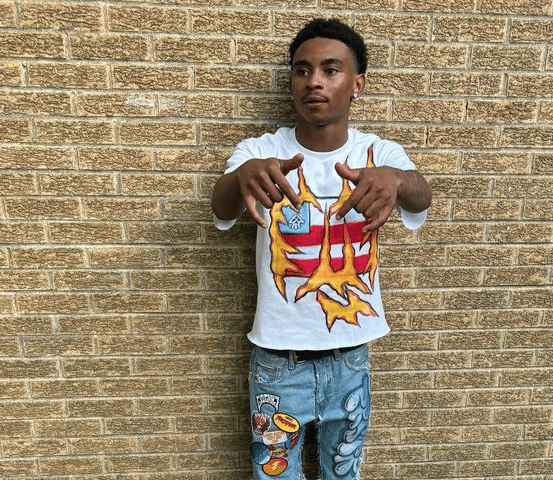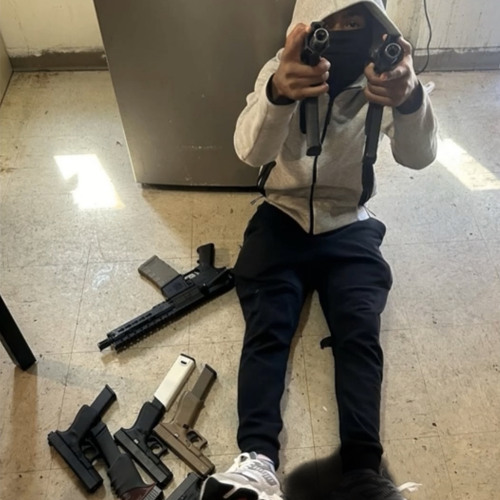The Violent Life and Death of Lil Scoom89: Chicago’s Drill Scene Nightmare
Dive into the brutal life and violent death of Chicago drill rapper Lil Scoom89 (Asyrion Hogan). Known for his savage diss tracks, gang affiliations, and reckless Instagram lives, Scoom’s rise and fall reads like a horror script from Chicago’s blood-soaked streets. This explicit deep dive explores his music, graphic details of his shooting on 89th and Langley, and the haunting online presence that foreshadowed his murder. Learn how Scoom’s world of drill rap, gang beef, and betrayal ended in a hail of bullets—and how his story intertwines with fellow fallen rapper Lil Jeff.
DISTURBING CASESHIP-HOP & RAP NEWSGRIM REALITYSINS OF THE FLESHRAPABYASSTRENDING
7/26/20258 min read


Introduction to Chicago's Drill Scene
Chicago's drill music scene has gained significant attention for its raw and unfiltered portrayal of urban life and the complexities of street culture. Emerging in the early 2010s, drill is characterized by its heavy use of trap beats, aggressive lyrics, and a focus on real-life experiences, particularly those related to violence, crime, and the struggles of living in difficult neighborhoods. The genre incorporates an array of influences from hip-hop, with a particular emphasis on storytelling that reflects the harsh realities faced by its artists and their communities.
The roots of drill music can be traced back to the culture of south and west side Chicago, where the realities of gang violence and systemic issues fueled the narratives that dominate the genre. Artists such as Chief Keef, Lil Durk, and King Von became prominent figures in this movement, using their music as a platform to express their personal struggles and the sociopolitical challenges that permeate their environment. Through their work, these artists not only provide insight into their own lives but also highlight the broader issues affecting many urban centers in America.
Drill music often revolves around themes of violence and street life, portraying an environment where survival is a constant battle. The genre has faced criticism for its explicit content and alleged promotion of gang culture, but many proponents argue that it serves as an essential outlet for expression and a means of coping with the realities of life in these neighborhoods. As drill continues to evolve, it remains a colorful and complex facet of Chicago's cultural landscape, shaping and reflecting the experiences of those who exist within it.
From 89th Street to Infamy: Lil Scoom89’s Gritty Rise
Asyrion Hogan, known as Lil Scoom89, wasn’t destined for peace. Raised in Chicago’s South Side, his teenage years were marked by violence, poverty, and gang ties. He funneled his rage into drill music, crafting raw, violent anthems like “In Scoom We Trust”. Scoom threatened enemies with chilling precision in his music and Instagram posts, showing off pistols, extended clips, and wads of cash like trophies.
“They shot at me, they missed. I won’t miss when I spin back. 89th made me heartless.”
(Lyrics from “No Love”)
Scoom wasn’t just a rapper; he was an instigator, calling out rivals and daring them to retaliate.
Lil Scoom89, born in Chicago, emerged from a city famed for its unique yet often tumultuous drill music scene. His early life was marked by the challenges of growing up in a neighborhood plagued by violence and socio-economic struggles. Influenced by the harsh realities surrounding him, he turned to music as a means of expression and escape. The genre of drill, characterized by its raw lyrics and heavy beats, provided a perfect outlet for Scoom89 to channel his experiences and those of his peers.
He first gained prominence with his gritty tracks that depicted street life, resonating with many young listeners who found a sense of realism in his lyrics. Through social media platforms, particularly Instagram and platforms like YouTube, Lil Scoom89 cultivated a substantial following, allowing his music to reach a broader audience. His tracks often featured collaborations with other notable drill artists, which not only enhanced his visibility but also established him as a respected figure within the community.
In his discography, tracks such as "Street Dreams" and "No Love" caught the attention of both fans and critics alike. The raw emotion conveyed in his lyrics and his authentic delivery set him apart from others in the genre. His music often served as a narrative of survival, reflecting both the pride and pain of his environment. The juxtaposition of melodic hooks and hard-hitting verses encapsulated the duality of life in Chicago.
As his popularity grew, so did the implications of his lifestyle, drawing attention not just to his music but also to the violent backdrop that surrounded him. Despite the challenges he faced, Lil Scoom89 managed to carve a niche for himself, ultimately becoming a voice for those who felt unheard. His journey serves as a testament to the power of music as a tool for storytelling and a means of understanding the complexities of urban life.
The Events Leading to His Death
July 7, 2019. The air over Chicago’s South Side was thick with heat and tension that night, the kind of swelter that made tempers snap like brittle wires. At 11:27 PM, gunshots cracked through the darkness near 89th and Langley, a rapid staccato that silenced the street for a split second before chaos erupted.
When first responders arrived, Lil Scoom lay sprawled across the uneven pavement, his once-crisp white T-shirt now clinging wet to his skin, dyed a deep, oozing red. The coppery tang of blood hung heavy in the humid air. Two ragged holes in his chest and shoulder pumped out crimson in violent spurts with each faint heartbeat, pooling beneath him and running in a thin stream down the curb.
Witnesses said he was trying to crawl, fingers scraping the asphalt, leaving a smeared trail as his strength gave out. His mouth opened and closed like a dying fish, choking on blood and half-formed words. Someone swore they heard him whisper, “Tell mama I’m sorry,” before the gurgling in his throat drowned it.
Paramedics dove in, hands slipping on the blood-slick ground, tearing open gauze and trying to plug the gaping wounds. But the chest wound was catastrophic—the bullet had shredded through muscle, ribs, and lung, leaving a cavity no amount of compressions could fix. As the ambulance tore toward the University of Chicago Hospital, Scoom’s pulse faded to nothing. He was pronounced dead minutes later under the sterile glow of ER lights.
The death of Lil Scoom89, a prominent figure within Chicago’s drill music scene, was not an isolated incident but rather the culmination of a complex interplay of events rooted in gang affiliations and societal factors. On the fateful day of his shooting at the intersection of 89th and Langley, tensions had already been simmering due to ongoing rivalries between various gangs in the area. These tensions were exacerbated by social media, which played a pivotal role in both escalating disputes and amplifying the visibility of confrontations.
In the months leading up to the shooting, Lil Scoom89 had been involved in a series of conflicts that were well-documented online. The nature of drill music, often characterized by its raw and unfiltered portrayal of street life, frequently blurred the lines between artistic expression and real-life consequences. His social media presence became a double-edged sword; it provided a platform for showcasing his talent and connecting with fans, while simultaneously drawing attention from rival groups who felt threatened by his influence and success.
On the day of the shooting, reports suggest that Lil Scoom89 had been targeted based on prior confrontations that had been publicly aired on social media. It is believed that specific posts and videos contributed to a climate of fear and retaliation, resulting in a tragic escalation that culminated in violence. The interplay of feuding gangs, alongside the reach of digital communication, illustrates the dangers that often accompany life in the drill scene. Indeed, social media acted as both a catalyst and a megaphone, intensifying the hostilities that ultimately led to the premature death of a young artist caught in a cycle of violence. This tragic event encapsulates the darker realities faced by many within the community, showcasing the urgent need for addressing the root causes of such conflicts.
The Ambush: Was Lil Scoom Backdoored?
Rumors immediately flooded Instagram and Reddit. Witnesses claimed Scoom was “backdoored” by two women he trusted, lured to the corner by a promise of drugs or sex. Instead, he walked straight into an ambush.
As he argued with the unknown gunman, shots rang out. Nearby, police discovered a 16-year-old boy bleeding in an Uber, hit in both thighs. He and Scoom were allegedly together moments before the shooting.
During the chaos, CPD officers spotted a suspect fleeing, gun in hand. The man fired on police during a foot chase, sparking a 10-1 emergency call. SWAT and multiple districts swarmed, but the shooter vanished into the shadows.
Digital Ghost: Lil Scoom’s Chilling Final Posts
Hours before his death, Scoom posted ominous Instagram stories:
“I’m still breathing. You opps better aim better next time.”
(Instagram, July 7, 2019)
His final tweet—now a digital memorial—read:
“When I go, just make sure they feel my pain too.”
Fans flooded his comments with RIP messages, while rivals mocked his death in their own diss tracks.
Gruesome Aftermath: A Blood-Soaked Scene
The crime scene was horrific. Pools of blood streaked across the cracked pavement where Scoom collapsed, his lifeless eyes staring blankly into the night sky. Shell casings littered the street like grim confetti.
Paramedics later described “chunks of flesh blown out from close-range gunfire” and damage to Scoom’s ribs and lungs so severe that “there was no chance of saving him.” His gold chain was ripped from his neck during the attack, later posted online by rivals as a trophy.
“They left Scoom leaking like a faucet. That’s what happens when you play the streets.”
(Anonymous comment, Chicago Drill Forums)
Scoom and Lil Jeff: Two Sides of the Same Coin
Lil Scoom’s story mirrors that of his friend Lil Jeff, another drill rapper murdered in gang crossfire. Together, they created a legacy of taunts, threats, and retaliatory violence that escalated until both were reduced to hashtags and murals.
“Jeff went first. Scoom followed. They both thought they were invincible.”
(Facebook comment, July 8, 2019)
Their deaths are now cautionary tales in Chicago’s drill scene—a brutal reminder of how quickly the streets swallow their stars.
Legacy and Impact on Chicago's Drill Scene
Lil Scoom89's life and tragic demise serve as poignant reminders of the complex interplay between artistry and the harsh realities of urban life in Chicago's drill scene. His untimely death has not only resonated within the community but has also ignited discussions about the cultural ramifications of drill music. The genre, characterized by its gritty and often violent narratives, reflects the struggles faced by young individuals in marginalized neighborhoods, and Lil Scoom89 was no exception. His contributions to the drill scene are notable, as they encapsulate both the aspirations and despairs of those who live in environments marked by societal turbulence.
The reaction from the community following Lil Scoom89's passing has been overwhelmingly poignant. Fellow artists, including notable figures like Lil Jeff, have echoed his story, reinforcing the sense of loss among fans and collaborators alike. These rappers often grapple with similar themes in their music, highlighting the cyclical nature of violence and its impact on personal and artistic expression. The narratives surrounding Lil Scoom89 have become cautionary tales that underscore the dire consequences of street life, serving as a lens through which others can reflect on their circumstances.
As drill music continues to evolve, the legacy of Lil Scoom89 poses significant implications for emerging artists. Navigating this genre requires a delicate balance between authenticity and the realities of violence that accompany it. For fans, the music remains a powerful outlet for understanding their own experiences; however, it also brings forth ethical questions regarding the glorification of a lifestyle that frequently leads to devastating outcomes. Ultimately, the life and legacy of Lil Scoom89 contribute to the ongoing dialogue about the responsibilities of artists within the drill scene and underscore the profound connection between music, violence, and community identity.
Final Thoughts: Another One Bites The Dust
Lil Scoom89’s life was a ticking time bomb of ego, violence, and self-destruction. He glorified death in his lyrics, mocked his rivals even at their gravesides, and lived as though bullets couldn’t touch him. But in the streets of Chicago, arrogance is no shield. The same reckless energy that fueled his music also sealed his fate.
When the shots rang out on 89th and Langley, Scoom became what he’d always rapped about: just another body in the gutter, another name on a growing list of South Side casualties. Justice? For many, there is none to seek. He courted chaos, and chaos answered.
Lil Jeff’s story mirrors his—another young man drunk on power and street fame, only to be swallowed by the same darkness he once wielded. In the end, neither was exceptional. They weren’t martyrs, just statistics in Chicago’s endless cycle of bloodshed.
Lil Scoom89’s life was a cocktail of music, violence, and reckless defiance. He rapped about death, laughed at threats, and posted photos with enemies’ graves in the background. In the end, his bravado couldn’t save him.
The man who pulled the trigger remains free. Justice for Scoom is as elusive as peace on Chicago’s South Side. For some, he’s a martyr. For others, just another statistic in the city’s endless bloodletting.
His own words foreshadowed his fate:
“If I die young, let the ops know I took one of theirs too.”
(“In Scoom We Trust”)
Sources:
Channel 3 Now – Chicago Rapper Lil Scoom Killed in Shooting
CPD Homicide Report – 89th and Langley
Chicago Sun-Times – South Side Violence


